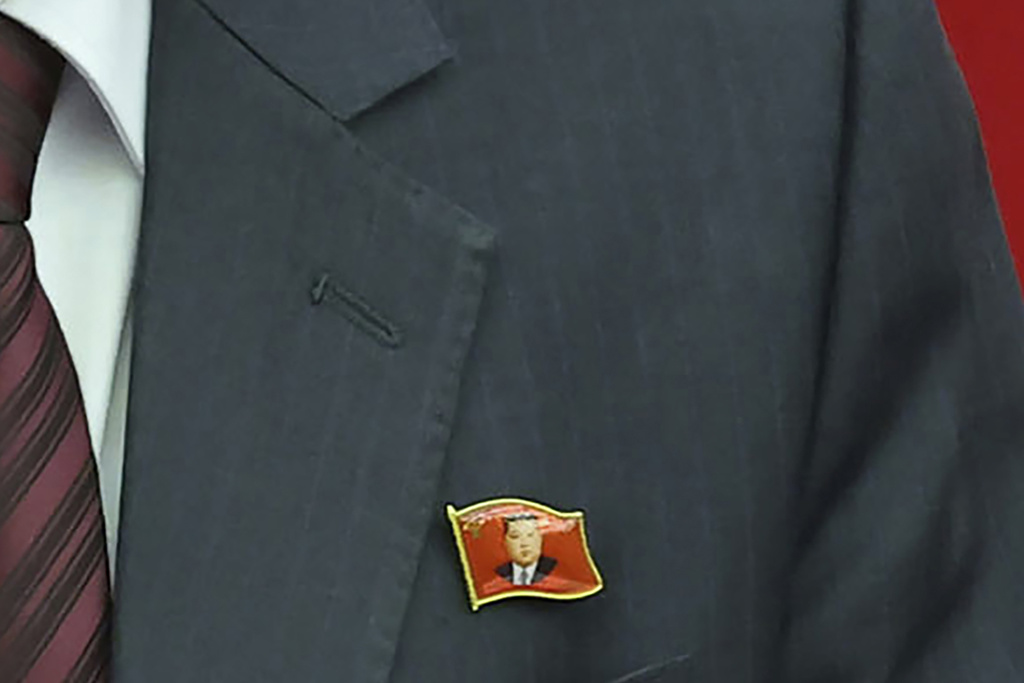Kim Jong Un Pins Now Worn by North Korean Officials as Personality Cult Grows

SEOUL, South Korea — For the first time, North Korean officials have been seen wearing lapel pins with the image of leader Kim Jong Un, a further indication that North Korea is bolstering his personality cult to the same level as that bestowed upon his deceased father and grandfather.
North Koreans are mandated to wear pins over their hearts, which for decades have depicted either the country’s founder, Kim Il Sung, or his son Kim Jong Il, or both. The existence of pins dedicated to Kim Jong Un had not been confirmed until state media published photos on Sunday showcasing officials donning his pins at a ruling Workers’ Party meeting.
The pins are part of a state-sponsored mythology surrounding the Kim family, which elevates Kim Il Sung and Kim Jong Il to the status of gods. They are commemorated with numerous statues across North Korea, their birthdays are two of the country’s main holidays, and their portraits are displayed in all homes and offices.
Few question current leader Kim Jong Un’s grip on power, but few images honoring the 40-year-old have been publicly exhibited since he assumed power in late 2011 following his father’s death. However, he has recently initiated steps to enhance his own personality cult while concurrently attempting to further distance himself from the legacies of his father and grandfather.
In May, Kim Jong Un’s portrait was publicly displayed alongside those of the other two Kims for the first time at a Workers’ Party-run training school. In January, Kim announced that he will cease nuclear weapons development with South Korea, a longstanding policy cherished by his father and grandfather. Observers also note that North Korea appears to be abstaining from using terms like “the Day of Sun,” a reference to the April 15 birthday of Kim Il Sung.
“The latest series of efforts to idolize Kim Jong Un is evaluated as a move to diminish his predecessors while establishing his authority as a leader” distinct from them, Kim Inae, a deputy spokesperson for South Korea’s Unification Ministry, informed reporters on Monday.
She stated that Kim is also likely attempting to foster internal solidarity behind his leadership as he navigates economic hardships and the influence of South Korean pop culture.
Ahn Kyung-su, head of dprkhealth.org, a website focused on health issues in North Korea, asserted that Kim Jong Un is striving to phase out symbols representing the legacies of his predecessors to promote his own era. However, as the third-generation leader in the Kim family, he will encounter difficulty in pushing too far, as this would weaken the legitimacy of its dynastic rule, said Ahn, who has interviewed numerous North Korean defectors and closely monitors North Korean state media.
“Kim Jong Un is in a predicament. He desires to distance himself further from his father’s and grandfather’s legacies, but he cannot do so,” Ahn remarked.
He mentioned that North Koreans are now expected to wear Kim Jong Un pins.
Leif-Eric Easley, professor of international studies at Ewha Womans University in Seoul, stated that the wearing of Kim Jong Un pins is not surprising, considering that he has been consolidating his rule for over a decade.
“The question is, now that Kim has emerged from the shadow of his predecessors, whether he will undertake policy adjustments to break with North Korea’s past economic failures,” Easley remarked.
In recent years, North Korea’s fragile economy has experienced further setbacks due to stringent pandemic restrictions, persistent U.N. sanctions, and its own mismanagement. During a Workers’ Party meeting on Saturday, Kim addressed “some deviations hindering” efforts to enhance the country’s economic standing, according to state media.
Some experts suggest that Kim’s actions are also linked to his reported drive to make his preteen daughter his heir in another hereditary power transfer.
indicated in January that it perceives Kim’s daughter, purportedly named Ju Ae and around 11 years old, as her father’s likely heir apparent. However, certain analysts contend that it is still too early to declare her Kim’s successor, citing her age and North Korea’s male-dominated hierarchy.
